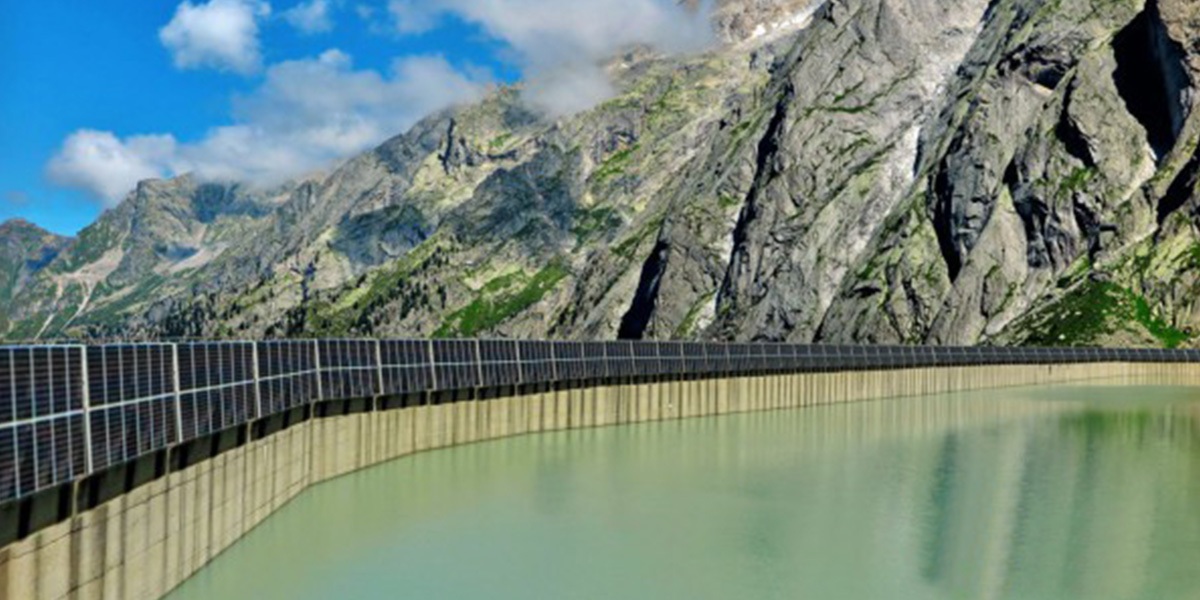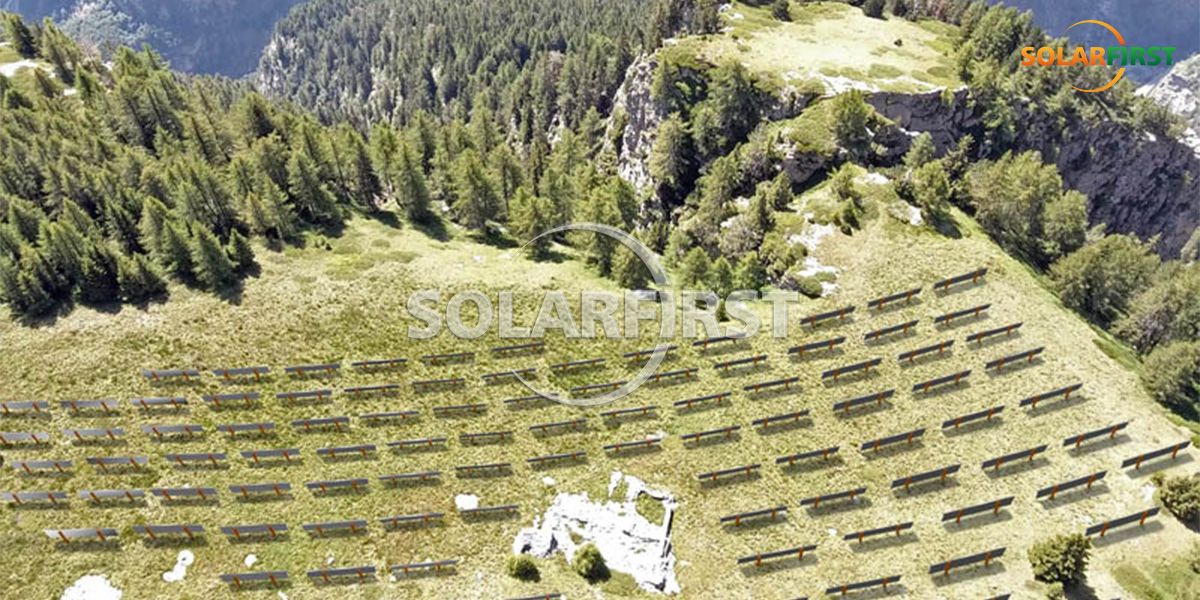Installing large-scale solar power stations in the Swiss Alps will significantly increase winter power generation and accelerate the energy transition. Late last month, the parliament agreed to advance the plan in a moderate way, which frustrated opposing environmental groups.
Studies show that installing solar panels high up in the Swiss Alps can generate at least 16 terawatt-hours (TWh) of electricity annually. This amount of electricity is equivalent to approximately 50% of the annual solar power generation target set by the Swiss Federal Energy Office (BFE/OFEN) for 2050. In the mountainous areas of other countries, China has several large-scale solar power stations, and France and Austria have also built small-scale facilities. However, large-scale facilities in the Swiss Alps are still rare at present.
Solar panels are usually installed on existing infrastructure, such as mountain huts, ski lifts and DAMS. For instance, photovoltaic power generation facilities in places like Muttsee in central Switzerland (at an altitude of 2,500 meters) fall into this category. Currently, approximately 6% of Switzerland's total electricity comes from solar power generation.

However, due to a sense of crisis over climate change and energy shortages in winter, the country is being forced to fundamentally re-examine itself. This autumn, the "Solar Offensive" initiated by several members of parliament called for simplifying and accelerating the approval process for the construction of solar power stations in the Swiss Alps.
Meanwhile, in the meadows of Valais, a Canton in southern Switzerland, two proposals for new solar power stations were submitted. One is a project called "Gondosolar" in the village of Gond near Simplon Pass, and the other is located to the north of Glengiols, with a larger planned scale.
The Gondosolar project, which cost 42 million Swiss francs (approximately 60 million US dollars), will install solar panels on 10 hectares (100,000 square meters) of private land in the mountains near the border between Switzerland and Italy. It is planned to install 4,500 solar panels. Renat Jordan, the landowner and project initiator, estimates that the power station can generate 23.3 million kilowatt-hours of electricity annually, which is sufficient to meet the electricity demands of at least 5,200 households in the area.
The municipality of Gond-Zwischbergen and the power company Alpiq also support this project. However, there is also intense controversy at the same time. In August this year, a group of environmental activists held a small but noisy protest on a planned meadow at an altitude of 2,000 meters.
Maren Koln, the head of the Swiss environmental group Mountain Wilderness, told swissinfo.ch: "I fully agree with the potential of solar energy, but I think it is important to give priority to existing buildings and infrastructure (where solar panels can be installed). There is still a lot of space in these places that has not been utilized. Before this space is exhausted, I don't think it's necessary to touch the undeveloped land."
The Federal Department of Energy estimates that installing solar panels on the rooftops and exterior walls of existing buildings can generate 67 terawatt-hours of electricity annually. This is far higher than the authorities' target of achieving 34 terawatt-hours of solar power generation by 2050 (2.8 terawatt-hours in 2021).
Experts point out that high-mountain solar power stations have multiple advantages, and most importantly, they are most active during the winter when power supply is usually tight.
Christian Schaffner, director of the Center for Energy Sciences at ETH Zurich, told Swiss Public Television (SRF) : "In the Alps, sunlight is particularly abundant, especially in winter, and electricity can be generated above the clouds." He also pointed out that using solar panels in the high-altitude Alps with lower temperatures is more efficient, and double-sided solar panels can be installed vertically to collect the reflected light from snow and ice.
However, there are still many unknown factors regarding solar power stations in the Alps, especially in terms of cost, economic benefits and suitable installation locations.
In August this year, a group of environmental activists held a protest at the planned construction site at an altitude of 2,000 meters © Keystone/Gabriel Monnet
Supporters estimate that the solar power station developed by the Gondosolar project will generate twice as much electricity per square meter as similar facilities in lowlands.
This power station will not be built in protected areas or regions with a high risk of natural disasters such as avalanches. They also claimed that these facilities could not be seen from neighboring villages. This project has applied to be included in the state-level planning and is currently under review. Even if approved, due to the planned completion in 2025, it will not be able to cope with the power shortage that is expected to occur this winter.
On the other hand, the Glengiols project is much larger in scale, with an investment of 750 million Swiss francs. It is planned to build a solar power station at an altitude of 2,000 meters near the village, which is the size of 700 football fields.
Valais Senator Beat Rieder told the German-language daily Tages Anzeiger that the Greengiors solar project has immediate feasibility and will increase power generation by 1 terawatt-hour (on the current basis). Theoretically, this could meet the electricity demand of a city with a population of 100,000 to 200,000.
However, environmentalists are increasingly concerned that the Brutal Nature Park, where such a huge facility is planned to be built, is a "regional nature park of national importance".
A project in the village of Greengiors, Valais, plans to build a solar power station the size of 700 football fields. SRF
But the mayor of Greengios, Armin Zeiter, refuted the claim that solar panels would damage the landscape. He told SRF: "Renewable energy exists precisely to protect nature." The local authorities approved the project in June and hope to launch it immediately, but the plan has not yet been submitted, and many issues such as whether the installation site is appropriate and how to connect to the grid remain unresolved. The German weekly newspaper Wochenzeitung reported on the relevant situation in a recent article about local opposition to the project.
The progress of these two solar projects has been slow amid ongoing disputes in the capital Bern over pressing issues such as climate change, future power supply, reliance on Russian gas, and how to get through this winter.
The Swiss Parliament approved a budget of 3.2 billion Swiss francs for climate change measures in September to achieve long-term carbon dioxide reduction targets. Part of the budget will also be used to address the current energy security threatened by Russia's invasion of Ukraine.
They also unanimously agreed on the need for more ambitious goals, namely doubling the output of renewable energy by 2035 and increasing solar power generation in lowland and mountainous areas.
Reed and a group of senators are pushing for simplified rules to accelerate the construction of large-scale solar power stations in the Swiss Alps. Environmentalists are shocked by calls for skipping environmental impact assessments and construction details.
Ultimately, the Bundestag reached a more moderate plan in accordance with the Swiss Federal Constitution. Alpine solar power stations with an annual power generation capacity of over 10 gigawatt-hours (GWh) will receive financial support from the federal government (up to 60% of the capital investment cost), and the planning process will be simplified.
But the parliament also decided that the construction of such large-scale solar power stations would be an emergency measure, usually prohibiting construction within protected areas and dismantling at the end of their service life. The parliament also mandates that all new buildings in Switzerland with a surface area of more than 300 square meters must be equipped with solar panels.
In response to this decision, the "Mountain Wilderness" organization stated: "We are relieved that the industrialization process in the Alps has not fully given the green light." However, they expressed dissatisfaction with the decision to exempt small buildings from the obligation to install solar panels, believing that this condition was seen as "holding back" the promotion of solar energy outside the Alps.
The environmental organization Franz Weber Foundation called the federal parliament's decision to support the construction of a large solar power station in the Alps "irresponsible" and called for a referendum on the law.
Natalie Lutz, a spokesperson for the environmental group Pro Natura, told swissinfo.ch that although she appreciated the parliament's revocation of "the most offensive and unconstitutional provisions" (such as the cancellation of the requirement for environmental impact studies), But she believes that "solar energy projects are still mainly being advanced at the expense of the natural environment of the Alps."
The industry responded promptly to this decision and has begun to advance multiple new project proposals. It is reported that after the Federal parliament voted to relax the construction process of solar power stations in the Alps, seven major power companies in Switzerland have begun to consider related projects.
The German Sunday newspaper NZZ am Sonntag reported on Monday that the industry interest group Solalpine is looking for 10 high-altitude areas as potential locations for solar power stations and will hold discussions with local governments, residents and relevant parties.
leave a message
Scan to wechat :
